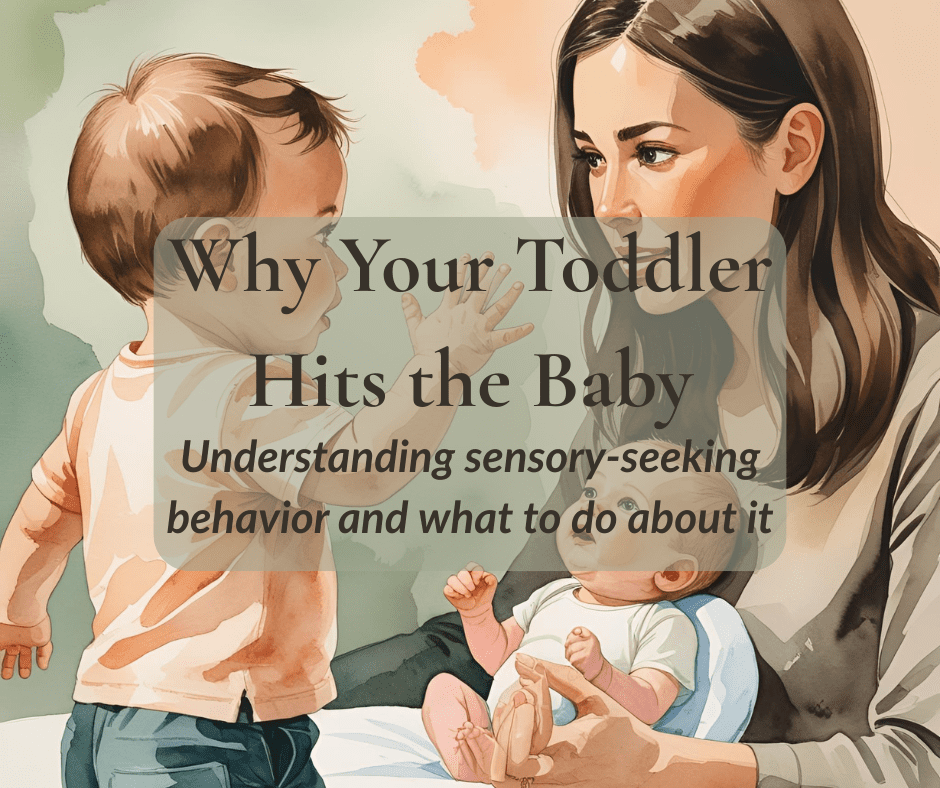The Reality No One Warns You About
You’re rocking the baby to sleep—again—when suddenly your toddler runs by and smacks her in the head. Or you turn your back for 30 seconds and find him tugging on the dog’s ears with a look of wild delight.
Before the guilt or shame creeps in, hear this: you’re not a bad parent, and your toddler isn’t a bad kid.
They’re sensory-seeking.
They’re under construction.
And believe it or not, there is a way through this.
What’s Really Behind Hitting and Biting?
Toddlers don’t have the brain maturity to think things through in the moment. That self-control switch you wish they had? It’s still being built—especially between the ages of 1 and 4.
But when the behavior becomes intense (hitting, biting, crashing), especially toward younger siblings or pets, it’s often linked to sensory-seeking behavior.
What is Sensory-Seeking?
Sensory seekers crave strong input. That means they may:
- Hit, push, or bite for the feeling of deep pressure
- Climb, crash, or throw things for proprioceptive input (body awareness)
- Chew, lick, or mouth objects to regulate through oral input
It’s not about being mean. It’s about meeting a nervous system need they don’t have the words for yet.
Why Does It Get Directed at the Baby (or Dog)?
- Easy targets. Siblings and pets are within reach and rarely fight back.
- Jealousy or unmet needs. A new baby brings big changes; toddlers may act out when they feel replaced or ignored.
- Lack of impulse control. Even when they know it’s wrong, their body acts faster than their brain.
An OT approach
Occupational therapy doesn’t just address the behavior. It addresses the root.
Here’s what an OT-informed approach looks like:
- Regulate First
- Behavior is communication. Look at what the body is seeking.
- Meet sensory needs before they boil over (preventative regulation).
- Redirect the Input
- Offer safe alternatives: crash pads, weighted blankets, sensory bottles.
- Replace biting with chewy tubes or frozen fruit in a mesh feeder.
- Co-Regulate in the Moment
- Stay calm. Kneel down. Narrate what happened.
- “You hit your sister. Your body is feeling wild. Let’s take a big bear hug and then find your pillow to hit.”
- Practice When Calm
- Roleplay with dolls: “What do we do when we feel wild?”
- Show them safe outlets before the next meltdown.
Looking for more activities that calm the nervous system…Click here
What You Can Do (Today)
1. Create a Sensory Toolkit
Sensory Safe Tools may include:
- Mini trampoline
- Weighted lap pad
- Chewable jewelry
- Fidget toys
- Crash-safe bean bag
Let your child choose what helps them calm their body.
2. Use Visuals
Create a simple chart with faces: calm, silly, wild, angry. Help your toddler label how they feel, then show what tools they can use.
3. Shadow Closely During High-Risk Times
Don’t leave baby and toddler alone yet. Step in before the hit happens. Gently hold their hands and say: “We keep baby safe. Let’s go stomp together instead.”
4. Reinforce the Positive
When they don’t hit? Celebrate it.
- “You used your words! That was kind.”
- “I saw you walk away when you felt mad. That was strong.”
What Not to Do
- Don’t shame. “What is wrong with you?” builds fear, not skills.
- Don’t isolate. Time-outs rarely teach regulation.
- Don’t ignore. Every moment is a chance to guide.
Will This Behavior Ever Stop?
Yes. But not overnight.
With support, structure, and steady regulation, many sensory-seeking toddlers learn safer ways to get their needs met. Their nervous systems mature, their impulse control catches up, and their empathy grows.
But they need your regulation first.
You can be the calm they borrow. Click here to learn more about Borrowing Calm.
You’re Not Failing—You’re Figuring It Out
Every parent with a spirited, sensory-seeking toddler has been where you are.
The hitting doesn’t mean they’re bad. The biting doesn’t mean you messed up. It means there’s more support needed, and now you have the tools to give it.
Take a breath.
Trust the process.
You’re doing important work—one redirect, one hug, one safe crash at a time.
👋 Want more tools to help? Download my FREE Sensory Seeker Support Guide with visuals, redirection ideas, and calming strategies for everyday moments.
For more parenting tips and support go to forgedbygrace.mom
Sources & Suggested Reading
- Siegel, D. & Bryson, T. (2011). The Whole-Brain Child.
- Porges, S. (2011). The Polyvagal Theory.
- Ainsworth, M.D.S. (1978). Patterns of Attachment.
- Tronick, E. (1975). Still Face Experiment. Harvard University.
- National Scientific Council on the Developing Child. (2014). Excessive Stress Disrupts the Architecture of the Developing Brain.
- Raver, C.C. (2004). Placing Emotional Self-Regulation in Sociocultural and Socioeconomic Contexts. Child Development, 75(2), 346–353.

View comments
+ Leave a comment